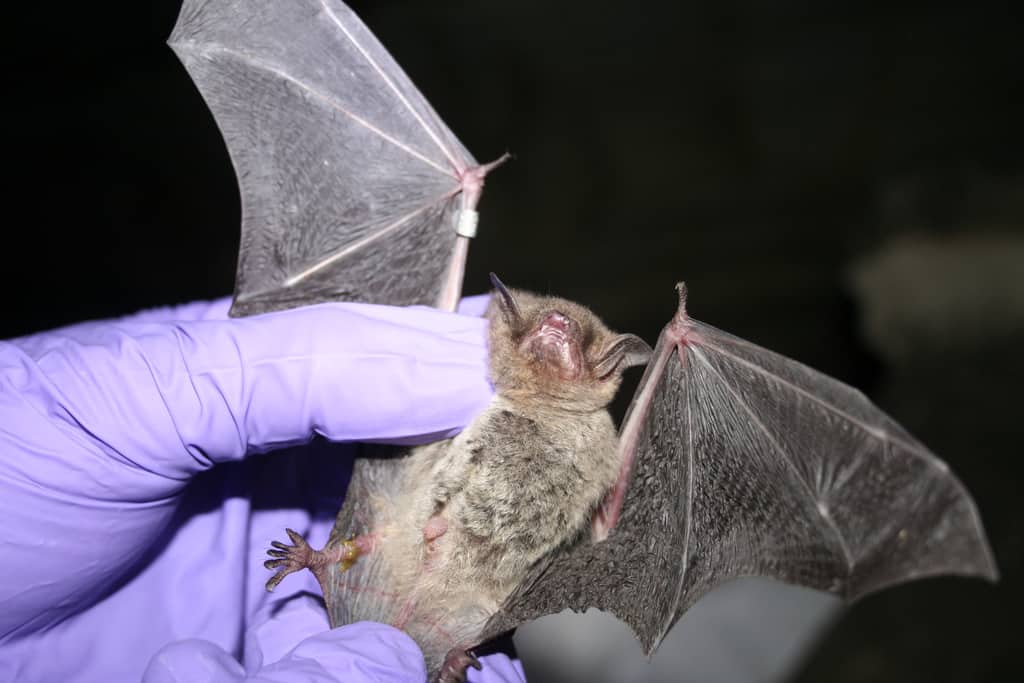More bad news for bats, I’m afraid—the U.S. Fish and Wildlife Service has confirmed that white-nose syndrome (WNS) has now spread to the endangered gray bat.
The fungus, which has devastated large populations of North American bats, was detected in Tennessee gray bats although biologists did not find evidence that it had killed any animals in this population yet.
WNS has been documented in 19 U.S. states and four Canadian provinces since it was first identified in 2006. Experts estimate nearly seven million bats have died of the disease so far.

The fungus has been detected in nine cave-hibernating bat species, and two additional species found in the affected area are at risk although infection has not yet been confirmed. The list includes the following species:Big brown bat (Eptesicus fuscus);Cave bat (Myotis velifer);Eastern small-footed bat (Myotis leibii);Gray bat (Myotis grisescens)*;Indiana bat (Myotis sodalist)*;Little brown bat (Myotis lucifugus);Northern long-eared bat (Myotis septentrionalis);Ozarks big-eared bat (Corynorhinus townsendii ingens)**;Southeastern bat (Myotis austroriparius);Tricolored bat (Perimyotis subflavus);Virginia big-eared bat (Corynorhinus townsendii virginianus)**.
The disease causes hibernating bats to become uncharacteristically active during cold winter months when they would normally be dormant. Infected bats have been observed flying outside during daylight hours and clustering near the entrances of their hibernacula rather than remaining inside as one would expect. These activities—or simply rousing repeatedly and prematurely from hibernation—deplete energy reserves that cannot be restored until the return of the insects upon which the bats feed. As a result, bats have been found sick and dying in large numbers in and around the caves and mines.
Even in the best of circumstances, staying put during the winter is a risky business for any insectivore. Survival depends on a bat’s ability to pack on enough fat during warm months to sustain it during the lean times when the mercury huddles at the bottom of the thermometer and insects are inactive. Reducing metabolic demand helps stretch those stored calories a little further, but if spring is slow to arrive temporary torpor can turn into a permanent sleep.
Preparing for the hibernation season is never an easy task. It’s even more difficult for females—they need to find enough food to sustain themselves and their nursing youngsters, plus gain the extra 15-30% of body weight they’ll need to see another spring.
A study published in April of this year suggests that WNS was introduced into a New York cave by a visitor from Europe. Sadly, bat experts have yet to come up with a way to treat or cure the disease, which has been known to kill up to 97% of the bats in an affected colony.
Gray bats were listed as endangered in 1976. They live in a small number of caves in the southeastern part of the U.S., and are particularly susceptible to diseases and human intrusion.
Looking for some good news about bats? Echolocate your way over toNext-Door Nature.
[*Endangered ; **WNS detected but infection unconfirmed]
Thanks to these photographers for making their work available through a Creative Commons license: [from top to bottom]:Ann Froschauer/USFWS(gray bat being examined for WNS and Kentucky bat ecologist counting gray bats); and Ryan von Linden/NYDEC(little brown bat with WNS fungus).
Kieran Lindsey
Kieran Lindsey loves looking for wild things in all the wrong places... so she became an urban biologist. Her quest to entice others to share this passion led to flirtations with (gasp!) the media—as a columnist for the Houston Chronicle; as host of KUNM-FM’s Wild Things; as producer of an Emmy® winning wildlife documentary; and at her Next-Door Nature blog. Kieran has way too much fun as official Animal-Vehicle Biologist for NPR's Car Talk, and she isn’t ashamed to admit it.


Leave a Reply